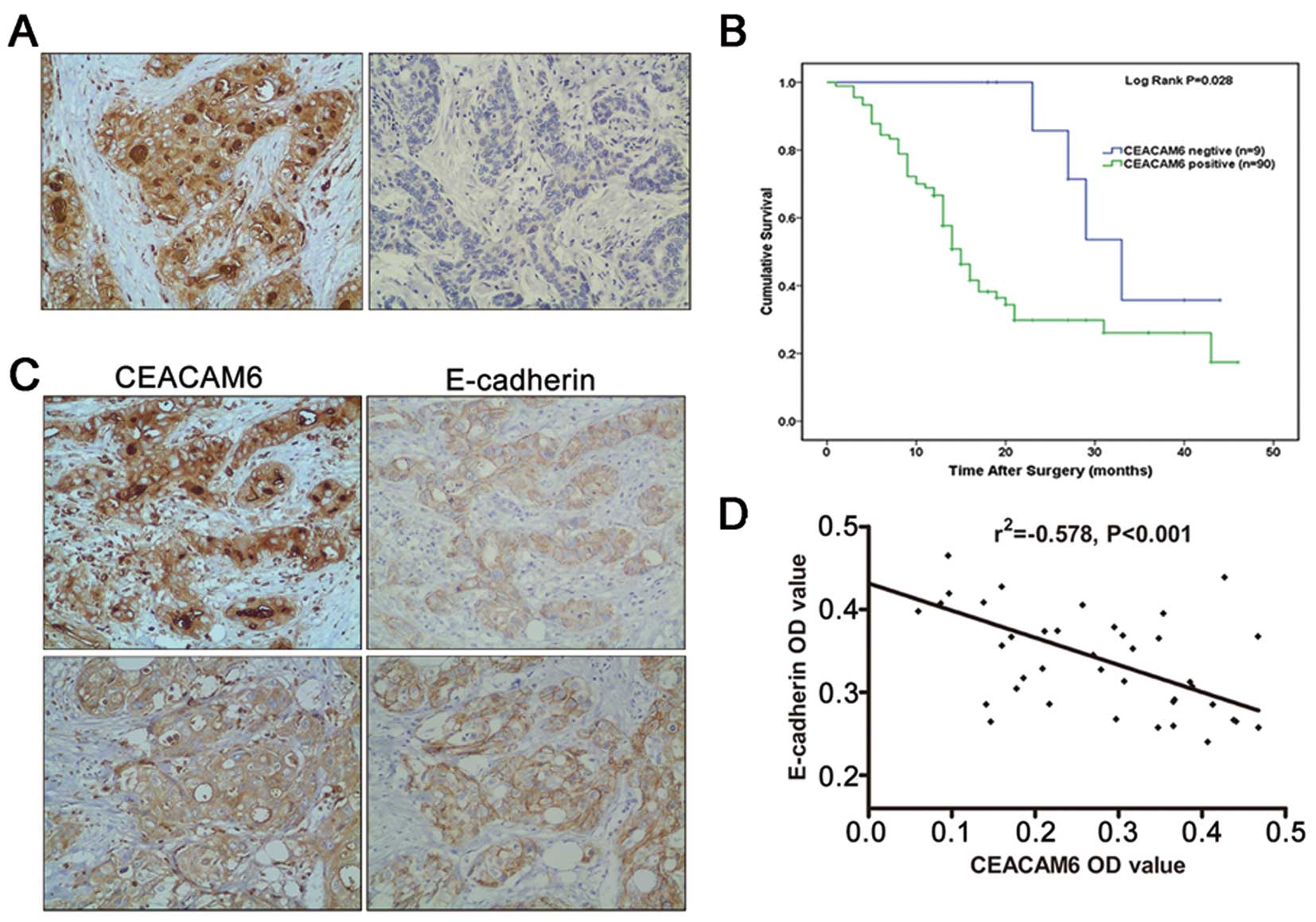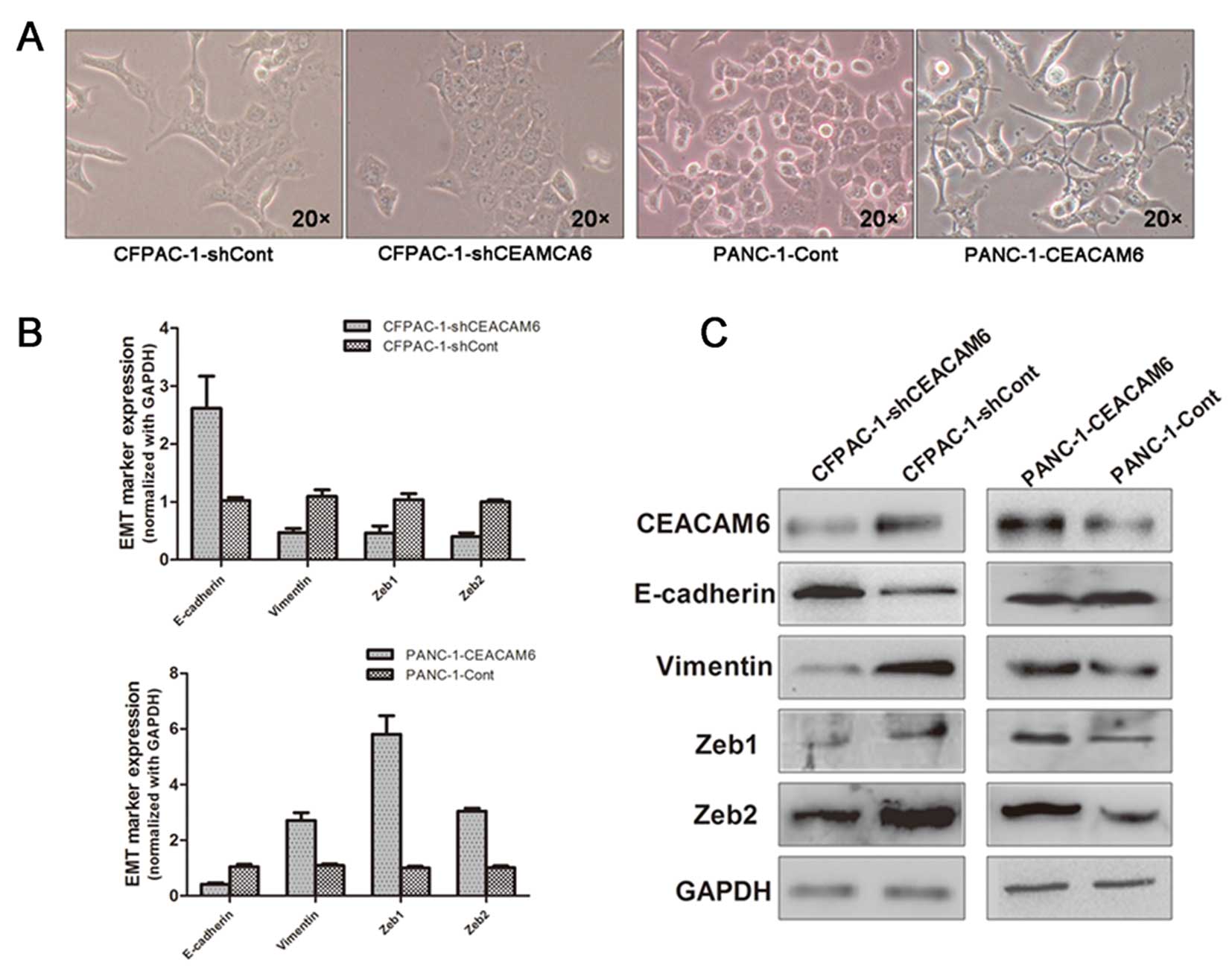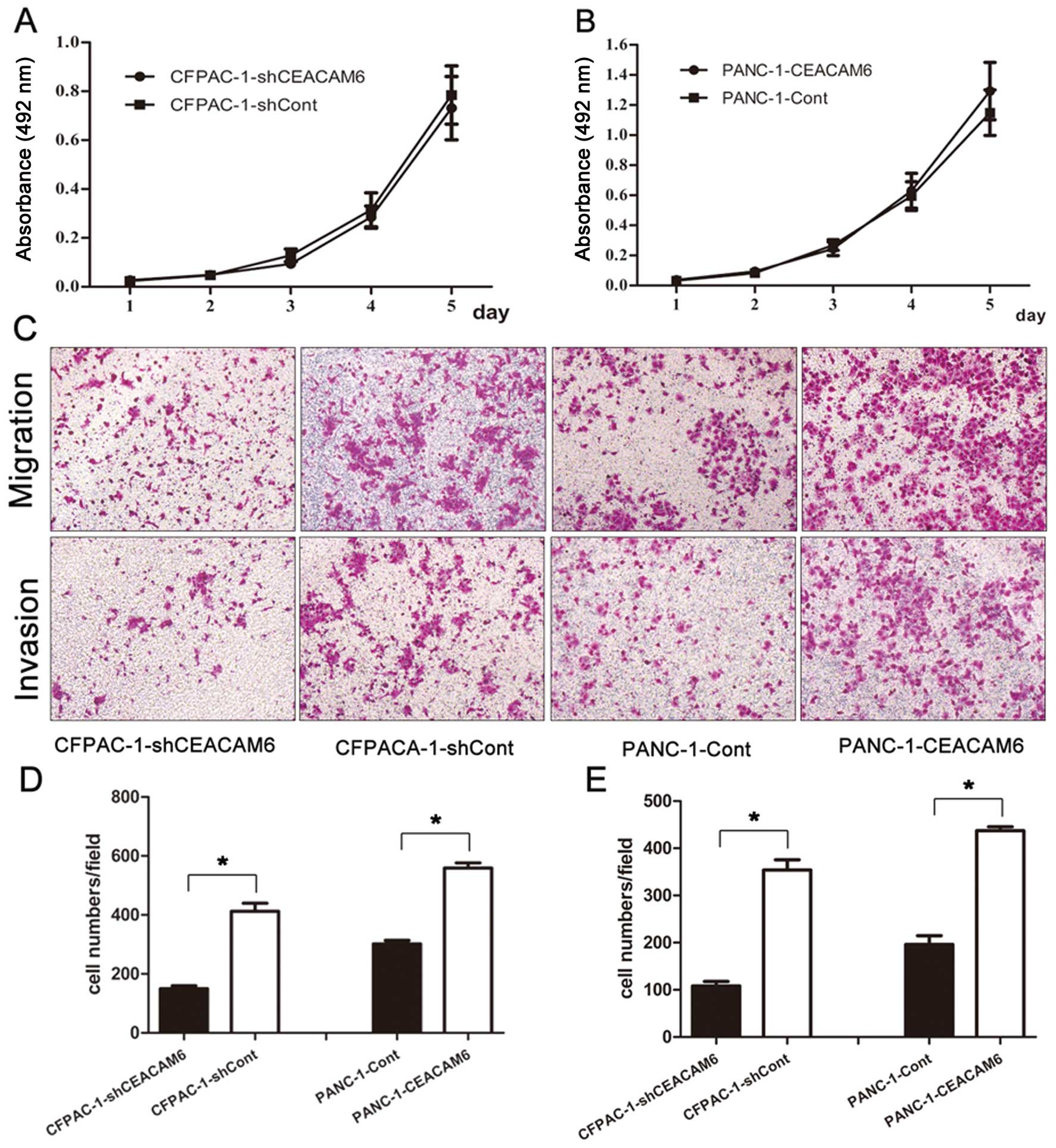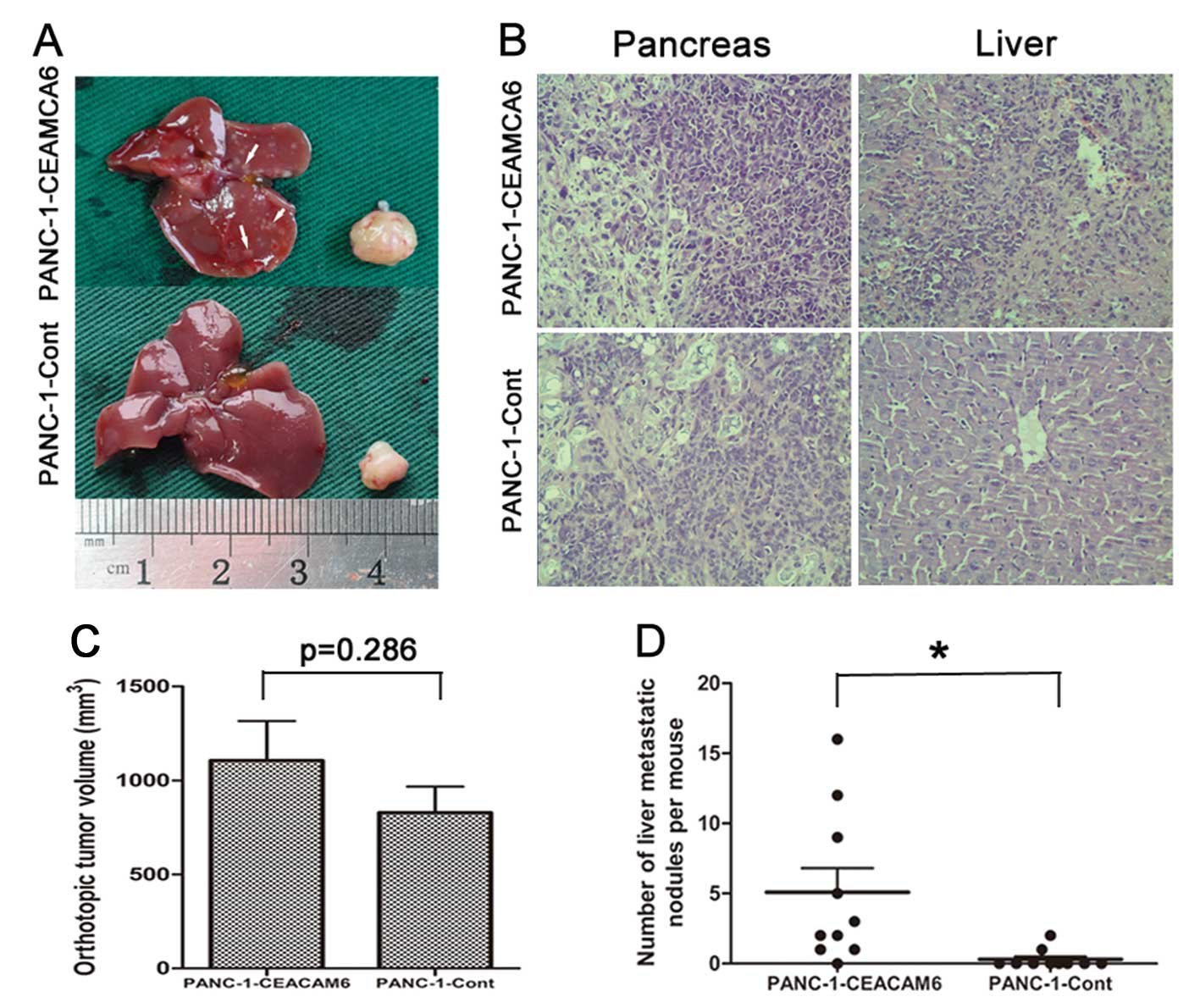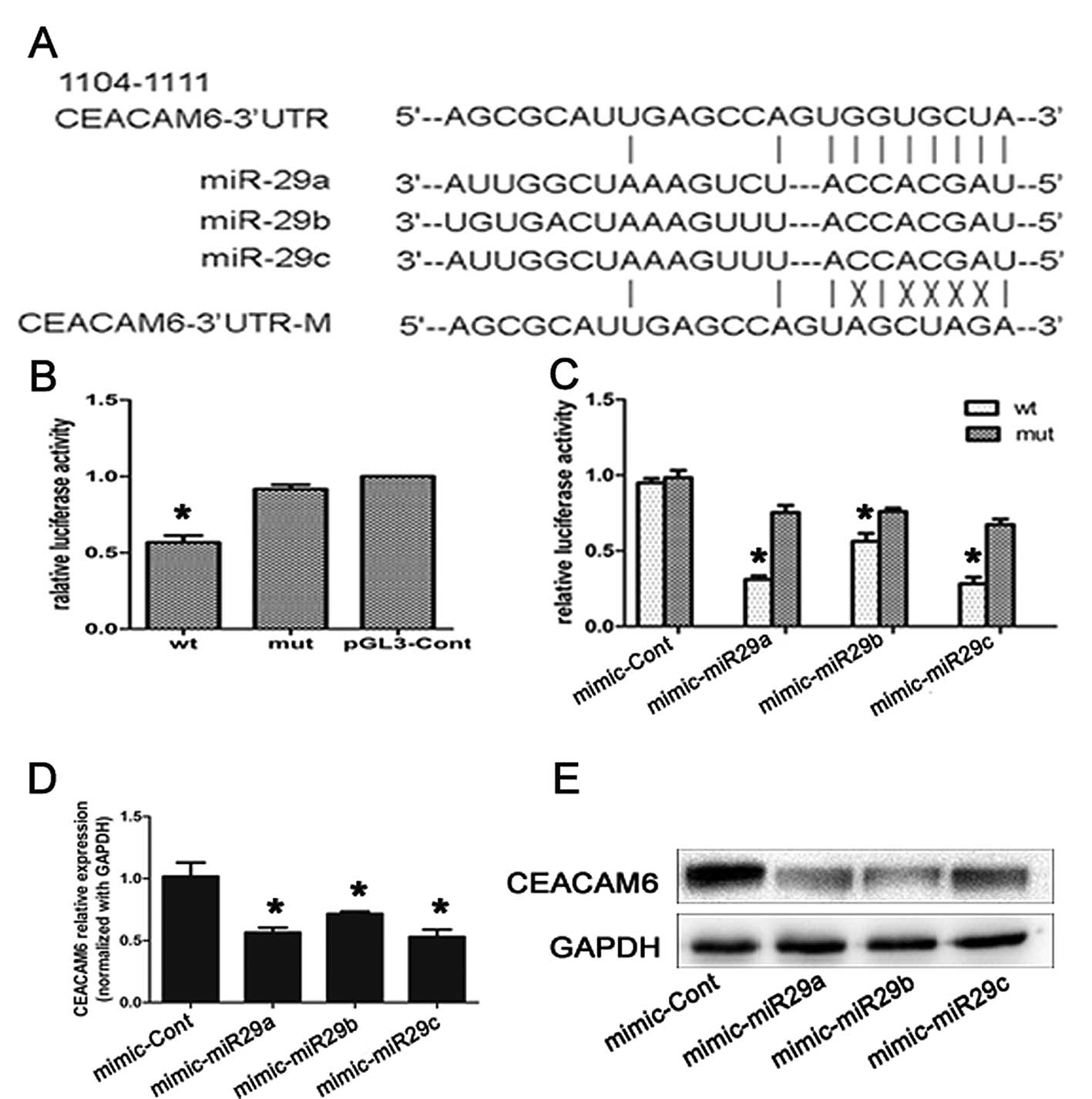CEACAM6 induces epithelial-mesenchymal transition and mediates invasion and metastasis in pancreatic cancer
- Authors:
- Published online on: July 12, 2013 https://doi.org/10.3892/ijo.2013.2015
- Pages: 877-885
Abstract
Introduction
Pancreatic cancer is the most lethal common malignancy, with estimated 43,920 new cases and 37,390 deaths occurring in the United States in 2012 (1). Despite the standardization of surgical techniques and advances in systemic treatments, <5% of patients survive 5 years after diagnosis; and this survival rate has remained unchanged for 40 years (2). Furthermore, <20% of patients are diagnosed with localized, potentially curable tumors at presentation; while 80–85% of patients present with an inoperable disease and rapidly succumb to this malignancy (3). In addition, pancreatic cancer responds poorly to most chemotherapeutic agents (3). Hence, there is an urgent need for a better understanding of the molecular mechanisms that contribute to pancreatic cancer development and progression as well as for new potential diagnostic and prognostic tumor markers.
Epithelial-mesenchymal transition (EMT) plays an important role in human physiology and pathophysiology in processes such as organ development, wound healing, organ fibrosis and cancer progression (4–6). This process is accompanied by dramatic changes in cellular morphology, the loss and remodeling of cell-cell and cell-matrix adhesions and the gain of migratory and invasive capabilities (4–7). In pancreatic cancer, induction of EMT leads to acquisition of invasive, metastatic properties as well as chemoresistance (8–10). Therefore, EMT might be an important mechanism involved in pancreatic cancer progression and might contribute to its poor prognosis. All these findings suggest that characterization of EMT effectors is likely to yield new insights into metastasis and novel avenues for treatment of pancreatic cancer.
MicroRNAs (miRNAs) are a class of small non-coding RNAs that post-transcriptionally regulate gene expression by pairing with complementary nucleotide sequences in the 3′-untranslated region (3′-UTR) of target mRNAs (11). Several previous studies have revealed that miRNAs play an important role in EMT and repress target mRNAs through translational downregulation and deadenylation (12–14).
Carcinoembryonic antigen-related cell adhesion molecule 6 (CEACAM6; 19q13.2) is a glycosylphosphatidylinositol (GPI)-linked immunoglobulin superfamily member. There is accumulating evidence that CEACAM6 is overexpressed in several epithelial carcinomas including colon, breast, non-small cell lung cancer and intrahepatic cholangiocarcinoma (15–19). In addition, it is involved in many crucial cellular events such as migration, invasion and tumorigenicity (20,21). Recent studies have suggested that CEACAM6 plays important roles in pancreatic cancer development and progression. Indeed, adenocarcinoma gene expression profiling studies have shown a 20- to 25-fold higher expression of CEACAM6 compared to normal pancreatic ductal epithelial cells (22). Moreover, deregulated overexpression of CEACAM6 has been shown to inhibit differentiation and anoikis (20). Conversely, knockdown of CEACAM6 has been shown to reverse anoikis resistance and inhibit the metastatic potential in pancreatic cancer mouse xenograft models in vivo by enhancing caspase-3-mediated apoptosis (21). In addition, CEACAM6 gene silencing markedly increased sensitivity to gemcitabine-mediated cytotoxicity (23).
Nevertheless, there are no previous studies on the role of CEACAM6 in pancreatic cancer EMT and the mechanisms regulating CEACAM6 expression in tumor progression still remain to be elucidated.
In the present study, we demonstrated that CEACAM6 is an important regulator of pancreatic cancer EMT, migration and invasion in vitro and metastasis in vivo. Furthermore, we showed that CEACAM6 might be a miR-29a/b/c target gene in the pancreatic cancer cell line CFPAC-1.
Materials and methods
Cell culture
Human pancreatic cancer cell lines CFPAC-1 and PANC-1 were purchased from Shanghai Cell Bank (Shanghai, China) and cultured in Dulbecco’s modified Eagle’s medium (DMEM) (Invitrogen, Carlsbad, CA, USA) supplemented with 10% fetal bovine serum (FBS) (Sigma, St. Louis, MO, USA), 2 mM glutamine, 100 μg/ml penicillin and 100 μg/ml streptomycin. All cells were incubated at 37°C in a humidified chamber supplemented with 5% CO2.
Immunohistochemistry
Pancreatic cancer tissue samples were obtained from 99 patients undergoing a pancreatectomy for pancreatic cancer at the First Affiliated Hospital of Nanjing Medical University between 2008 and 2010 and were confirmed by a pathologist. All patients provided informed consent for their participation in the study, which was approved by the Ethics Committee of Nanjing Medical University, China.
For the immunohistochemistry analysis, 4-μm thick paraffin-embedded tissue sections were deparaffinized in xylene, rehydrated in graded alcohol and blocked in methanol containing 3% hydrogen peroxide. The slides were covered with a blocking solution for 1 h at room temperature and incubated with mouse anti-human CEACAM6 monoclonal antibody (Abcam, Cambridge, MA, USA) or mouse anti-human E-cadherin monoclonal antibody (Abcam) for 2 h at 37°C. After rinsing with phosphate-buffered saline (PBS; pH 7.4) solution, sections were treated with a goat anti-mouse secondary antibody (Santa Cruz Biotechnology, Santa Cruz, CA, USA) for 1 h at 37°C. Next, the slides were incubated with 3,3-diaminobenzidine (DAB) solution for 10 min and then counterstained with hematoxylin. CEACAM6 and E-cadherin expression were quantified using Image-Pro Plus version 6.0 (Media Cybernetics, Inc., Bethesda, MD, USA).
Generation of stable cell lines
For the generation of stable cell lines in our study, CEACAM6 lentiviral constructs were amplified using PrimeSTAR HS DNA Polymerase (Takara, DR010A, Dalian, China) and ligated into the Lv-CMV-EGFP vector. The shRNAs for human CEACAM6 were designed in our lab and constructed in pLKO.1-puro vectors. Three shRNA plasmids were constructed against different CEACAM6 coding sequence (CDS) regions and a scrambled sequence was made as a negative control. All plasmids were verified by sequencing (Invitrogen). After infection with lentivirus, cells were tested for CEACAM6 gene overexpression or knockdown efficiency. One construct with ≥80% knockdown efficiency was selected and used in further studies. The shRNA sequences used in knockdown studies were as follows: shCEACAM6 (sense: 5′-GCCCCAGAAUCGUAUUGGUTT-3′ and antisense: 5′-ACCAAUACGAUUCUGGGGCTT-3′) and shCont (sense: 5′-UUCUCCGAACGUGUCACGUTT-3′ and antisense: 5′-ACGUGACACGUUCGGAGAATT-3′).
Real-time quantitative reverse transcription PCR (qRT-PCR)
For the real-time quantitative RT-PCR analysis, total RNA was extracted using TRIzol reagent (Invitrogen) and cDNA was synthesized using the PrimeScript RT kit (Takara). Real-time quantitative reverse transcription PCR (qRT-PCR) was performed using a FastStart Universal SYBR Green Master (Rox) (Roche, USA) and ABI PRISM 7500 Sequence Detection System (Applied Biosystems, Life Technologies Corp., CA, USA). The relative expression of mRNA was examined as the inverse log of the ΔΔCt and normalized to the reference gene, GAPDH. Primers for qPCR were synthesized by Invitrogen (Shanghai, China) and the sequences were as follows: CEACAM6 sense: 5′-AGAAGCTAGCAGAGACCATGGGACCC-3′, antisense: 5′-AAATTCTAGAGGGCTGCTATATCAGAGCC-3′. GAPDH sense: 5′-TCACCCACACTGTGCCCATCTACGA-3′, antisense: 5′-CAGCGGAACCGCTCATTGCCAATGG-3′. The other primers are available upon request.
The miR-29a/b/c level was quantified by qRT-PCR using a TaqMan probe (Applied Biosystems, Foster City, CA, USA), with RNU6B small nuclear RNA as an internal reference. Their relative levels were analyzed in triplicate on an ABI PRISM 7900 Sequence Detection System (Applied Biosystems), according to the manufacturer’s protocol.
Western blot analysis
For the western blot analysis, cells were lysed using a RIPA buffer with 1% phenylmethanesulfonyl fluoride (PMSF). Protein concentration was measured using a BCA kit (Keygen, Nanjing, China). Equal amounts of protein (30 μg) were resolved with 10% SDS-PAGE and transferred to polyvinylidene difluoride (PVDF) membranes (Millipore, Bedford, MA, USA). Membranes were probed with primary antibodies for 12 h at 4°C and then incubated with secondary antibodies for 2 h at room temperature. CEACAM6 (1:250), E-cadherin (1:1,000), vimentin (1:500) and ZEB1 (1:100) antibodies were from Abcam and the ZEB2 (1:200) antibody was from Santa Cruz Biotechnology. The goat anti-rabbit and goat anti-mouse secondary antibodies were from Beyotime (Nantong, China). GAPDH antibody (1:500) (Beyotime) was used as an internal control. Electrochemiluminescence was performed with a ChemiImager 5500 imaging system (Alpha Innotech Co., San Leandro, CA, USA).
Target prediction and microRNA transfection
Three online programs, TargetScan (http://www.targetscan.org), Microcosm Targets (http://www.ebi.ac.uk) and microRNA (http://www.microrna.org) were used for predicting miRNAs that might target CEACAM6. CFPAC-1 cells overexpressing CEACAM6 were used for target miRNA verification. The miRNA mimics were designed and synthesized by Genepharma (Shanghai, China). The miR-29a/b/c mimics and the negative control were as follows: miR-29a sense: 5′-UAGCACCAUCUGAAAUCGGUUA-3′ and antisense: 5′-ACCGAUUUCAGAUGGUGCUAUU-3′; miR-29b sense: 5′-UAGCACCAUUUGAAAUCAGUGUU-3′ and antisense: 5′-CACUGAUUUCAAAUGGUGCUAUU-3′; miR-29c sense: 5′-UAGCACCAUUUGAAAUCGGUUA-3′ and antisense: 5′-ACCGAUUUCAAAUGGUGCUAUU-3′; negative control sense: 5′-UUCUCCGAACGUGUCACGUTT-3′ and antisense: 5′-ACGUGACACGUUCGGAGAATT-3′.
MicroRNA transfection was performed using Lipofectamine 2000 (Invitrogen). In brief, CPFAC-1 cells were grown in 6-well plates to 50% confluency before transfection. Total RNA and proteins were extracted at 48 h post-transfection and used for qRT-PCR and western blot analysis, respectively.
Luciferase reporter assay
For the luciferase reporter assay, reporter plasmids were constructed by ligating 60-bp synthetic oligonucleotides (Invitrogen) containing putative miRNA binding sites from the human CEACAM6 3′-UTR or their mutant versions into XbaI-FseI sites of the pGL3-control vector (Promega, Madison, WI, USA). Cells were plated at 1.5×105 cells/well in 24-well plates 24 h before transfection. Cells were transfected with 200 ng of luciferase reporter plasmid plus 80 ng of pRL-TK (Promega) in combination with 60 pmol of the microRNA mimics or negative control using Lipofectamine 2000 (Invitrogen). Luciferase activity was measured 48 h after transfection using the Dual-Luciferase Reporter Assay System (Promega). Firefly luciferase activity was normalized to renilla luciferase activity for each transfected well.
Cell proliferation assay
Cell proliferation was assessed by the MTT assay. Cells were plated at 1,000 cells/well on 96-well plates. Twenty microliters of MTT (5 mg/ml) was added to each well and plates were incubated for 4 h at 37°C, then 200 μl of DMSO was added to each well and plates were agitated for 15 min. The optical density (OD) value of each well was determined by measuring the absorbance, respectively, at 492 and 620 nm (reference). Survival percentage (%) was calculated relative to the control.
Cell migration and invasion assay
The cell migration assay was performed using 6.5-mm chambers with 8-μm pores (Corning, Corning, NY, USA). In brief, cells were seeded in the upper chambers in serum-free DMEM (1×104 cells in 200 μl) and 600 μl of 10% FBS-DMEM was added into the lower wells. After 24 h at 37°C, cells migrating to the bottom of the membrane were stained with 0.1% crystal violet in methanol. Images of three random ×10 magnification fields were captured from each membrane and the number of migratory cells was counted. For the cell invasion assay, similar inserts coated with Matrigel were used to determine the invasive potential of the cells. All experiments were done in triplicate.
Orthotopic pancreatic tumor xenograft model
Athymic nude mice (BALB/cA-nu (nu/nu)) (4–6-week-old) were purchased from the Nanjing Medical University Animal Center (Nanjing, China). Mice were anesthetized with 2.5% avertin and the injection site was cleaned with 70% ethanol. A 1-cm incision was made in the left subcostal region and the pancreas was exposed. A solution of 1×106 PANC-1-CEACAM6 or PANC-1-Cont cells in 30 μl of PBS was injected into the tail of the pancreas (ten mice per group). The peritoneum and skin were closed with a 4-/T0 surgical suture. Four weeks post-inoculation, all surviving mice were sacrificed and evaluated macroscopically for the presence of orthotopic tumors and metastases in the liver. Tumor volumes were determined by the formula: tumor volume (mm3) = [length (mm)] × [width (mm)]2 × 0.52 (24).
Statistical analysis
All experiments were repeated in triplicate. All values were expressed as mean ± standard deviation (SD). Statistical significance was determined using the Student’s t-test, Kaplan-Meier survival analysis, log-rank test and Spearman correlation using SPSS 17.0 (Chicago, IL, USA). P<0.05 were considered as statistically significant.
Results
CEACAM6 expression in pancreatic cancer is correlated with clinicopathological characteristics and the EMT marker E-cadherin
In this study, we examined the expression of CEACAM6 in 99 pancreatic tumor tissue samples by immunohistochemistry. Positive CEACAM6 immunohistochemical reaction was localized to the membrane and cytoplasm of tumor cells (Fig. 1A) and was detected in 90.9% (90/99) of samples. Furthermore, we examined the correlation between CEACAM6 expression and the clinicopathological characteristics of patients. The results of this analysis are summarized in Table I.
Table IAssociation between CEACAM6 imunohistochemical expression and clinicopathological characteristics of pancreatic cancer patients. |
In brief, CEACAM6 expression correlated with tumor differentiation and positive lymph node status (P<0.05); however, no correlation of CEACAM6 expression with patients’ age, gender, tumor location, tumor size, perineural invasion, or T stage was observed (P>0.05). Furthermore, according to the Kaplan-Meier test, patients with CEACAM6-negative tumors had significantly longer overall survival, compared with those with CEACAM6-positive tumors (P<0.05) (Fig. 1B).
Additionally, we examined the expression of the EMT marker E-cadherin by immunohistochemistry and correlated it to CEACAM6 expression. A positive immunohistochemical reaction for E-cadherin was observed mainly on membranes of normal glands and cancer cells (Fig. 1C). Pearson correlative analysis indicated significantly negative correlations between CEACAM6 and E-cadherin expression (P<0.01) (Fig. 1D).
CEACAM6 promotes EMT in pancreatic cancer cells
To determine the potential role of CEACAM6 in regulating EMT in pancreatic cancer, we analyzed the influence of CEACAM6 overexpression and silencing in PANC-1 and CFPAC-1 pancreatic cancer cell lines, respectively.
To analyze the influence of CEACAM6 overexpression, we transfected the CEACAM6 expression vector Lv-CMV-EGFP-CEACAM6 or the control vector Lv-CMV-EGFP into PANC-1 cells, which typically express low levels of CEACAM6. The overexpression of CEACAM6 in PANC-1 cells induced loose cell contact and spindle-shaped morphology reminiscent of EMT, while cells transfected with the control vector maintained the cobblestone-like morphology (Fig. 2A). Next, we observed that elevated expression of CEACAM6 significantly increased the expression of the mesenchymal marker vimentin but decreased the expression of the epithelial marker E-cadherin (Fig. 2B and C, respectively).
Furthermore, in the silencing experiment, we transfected the pLKO.1-puro-shCAECAM6 vector or the control vector pLKO.1-puro-shScramble into CFPAC-1 cells, which typically express high levels of CEACAM6. Knockdown of CEACAM6 in CFPAC-1 cells led to typical transition from mesenchymal to epithelial morphology and a concomitant decrease in vimentin and increase in E-cadherin expression, as evidenced by both qRT-PCR and western blot analysis. Collectively, these findings indicate that altered CEACAM6 expression affects pancreatic cancer cell EMT in vitro.
Furthermore, we examined the levels of the known EMT activators ZEB1 and ZEB2 in relation to CEACAM6 overexpression or knockdown in pancreatic cancer cell lines. ZEB1 and ZEB2 expression was significantly increased in PANC-1 cells overexpressing CEACAM6; whereas in CFPAC-1 cells transfected with CEACAM6, the expression of the silencing vectors ZEB1 and ZEB2 was repressed (Fig. 2B and C, respectively). These results suggest a potential role of ZEB1 and ZEB2 in CEACAM6-regulated EMT.
Functional role of CEACAM6 in pancreatic cancer cell proliferation, migration and invasion in vitro
CEACAM6 knockdown and overexpression did not markedly affect the proliferative ability of CFPAC-1 and PANC-1 cell lines (CFPACA-1-shCEACAM6 vs. CFPAC-1-shCont: 0.731±0.129 vs. 0.785±0.119, P=0.626; PANC-1-CEACAM6 vs. PANC-1-Cont: 1.293±0.190 vs. 1.149±0.150, P=0.364) (Fig. 3A and B, respectively). Although the results were not consistent with the impact of altered CEACAM6 expression on proliferation of pancreatic cancer cells in vitro, the data showed that overexpression of CEACAM6 promoted the migration (PANC-1-CEACAM6 vs. PANC-1-Cont: 559.1±51.9 vs. 301.6±36.2, P<0.01) and invasion (PANC-1-CEACAM6 vs. PANC-1-Cont: 437.2±25.1 vs. 196.2±56.2, P<0.01) abilities of PANC-1 cells (Fig. 3D and E, respectively), whereas knockdown of CEACAM6 attenuated cell migration (CFPACA-1-shCEACAM6 vs. CFPAC-1-shCont: 149.7±30.3 vs. 412.2±83.1, P<0.01) and invasion (CFPACA-1-shCEACAM6 vs. CFPAC-1-shCont: 108.2±27.9 vs. 354.1±64.0, P<0.01) in CFPAC-1 cells (Fig. 3C, D and E, respectively).
Overexpression of CEACAM6 enhances metastatic ability of PANC-1 cells in vivo
To assess the significance of CEACAM6 expression in vivo, PANC-1-CEACAM6 cells were orthotopically injected into the pancreas of nude mice, while PANC-1-Cont cells were used as a control. Four weeks after injection, mice were sacrificed and tumor volume and metastatic liver nodules were counted and confirmed histologically (Fig. 4A and B, respectively).
The tumor volume showed no significant difference between the two groups (PANC-1-CEACAM6 vs. PANC-1-Cont: 1105.5±666.7 mm3 vs. 828.5±439.2 mm3, P=0.286) (Fig. 4C). Nevertheless, a statistically significant difference in the mean metastatic liver nodule number in PANC-1-CEACAM6 and PANC-1-Cont groups was observed (5.10 and 0.30, respectively, P<0.05) (Fig. 4D).
Modulating effect of miR-29a/b/c on CEACAM6 expression
Using bioinformatic tools (TargetScan, Microcosm Targets and microRNA), we predicted that miR-29a/b/c might be the most potent regulator of the CEACAM6 gene. Therefore, we decided to test our hypothesis in CFPAC-1 cells using a constructed reporter plasmid carrying the CEACAM6 wild-type and mutant-type 3′-UTR region (Fig. 5A).
As shown in Fig. 5B and C, miR-29a/b/c significantly suppressed luciferase activity when the wild-type 3′-UTR of CEACAM6 was present (P<0.05). To verify that miR-29a/b/c acts as a negative regulator of CEACAM6 translation, we transfected CFPAC-1 cells with miR-29a/b/c mimics and tested the endogenous CEACAM6 mRNA and protein expression levels by qRT-PCR and western blot analysis, respectively. CEACAM6 mRNA levels decreased 48 h after miR-29a/b/c transfection (Fig. 5D, P<0.05). Additionally, western blot analysis showed that 48 h after transfection, overexpression of miR-29a/b/c resulted in a significant decrease in CEACAM6 protein level (Fig. 5E). These results collectively suggest that miR-29a/b/c may, at least in part, be responsible for the regulation of CEACAM6 expression in vitro.
Discussion
Pancreatic cancer is the tenth most common cancer and the fourth most common cause of cancer mortality worldwide (1). In the past few decades, great efforts have been made to elucidate the molecular mechanisms underlying its tumorigenicity, invasion and metastasis in order to find new potential diagnostic and prognostic markers for early detection as well as to develop new targeted anticancer therapies. Nevertheless, the detailed mechanisms of pancreatic cancer development and progression to metastasis still remain obscure.
Previous studies have shown that CEACAM6 is overexpressed in many carcinomas, including pancreatic cancer (15,18,19,25). It has been suggested that CEACAM6 overexpression is associated with greater resistance to anoikis and high cellular invasion potential in vitro as well as higher metastatic potential in vivo(21,26–28). The reason why CEACAM6 overexpression is associated with aggressive biological behavior of cancer cells has not been fully clarified.
In the present study, we found that CEACAM6 was highly expressed in most pancreatic cancer tissue samples and this expression was closely associated with poor prognosis in pancreatic cancer patients. In addition, we have for the first time demonstrated that CEACAM6 directly impacts EMT, migration, invasion and metastasis of pancreatic cancer cells. More importantly, our study is the first to show that miR-29a/b/c can regulate CEACAM6 at the post-transcriptional level.
Emerging evidence suggests that EMT is associated with the loss of epithelial and gain of mesenchymal characteristics, resulting in an increased invasive, metastatic and chemo-resistance potential of tumor cells and thus having an important role in cancer progression and prognosis (29,30). In the present study, we found that CEACAM6 is highly expressed in most pancreatic tumor tissues. Clinicopathological analysis revealed that expression of CEACAM6 protein was significantly related to tumor differentiation and lymph node metastasis. Our results are in agreement with those of a previous study by Duxbury et al in which the expression of CEACAM6 correlated with tumor grade and positive lymph node status (25). In addition, the observed cell morphology, molecular biomarkers and biological behavior found in our study were consistent with EMT characteristics. Moreover, we demonstrated that elevated CEACAM6 expression could contribute to EMT phenotype acquisition characterized by the typical mesenchymal morphology, through its influence on upregulation of the mesenchymal cell marker vimentin and downregulation of the epithelial cell marker E-cadherin. Conversely, decreased CEACAM6 expression in our study was associated with the reversal of EMT through downregulation of vimentin and upregulation of E-cadherin. Furthermore, these results are consistent with the observed clinical data that showed a significantly negative correlation between CEACAM6 and E-cadherin expression in 40 pancreatic cancer tissues.
ZEB1 and ZEB2, two members of the ZEB family, are important regulators of EMT and are implicated in the tumorigenesis of many human cancers (12,31). We found that ZEB1 and ZEB2 expression was significantly increased in PANC-1 cells overexpressing CEACAM6. On the contrary, ZEB1 and ZEB2 expression was repressed in CFPAC-1 cells in which the CEACAM6 was silenced. Based on these findings, we can speculate on the possible role of CEACAM6 in EMT regulation through its effects on ZEB1 and ZEB2.
The functional study of the role of CEACAM6 in pancreatic cancer cell lines demonstrated that PANC-1 cells, which typically express low levels of CEACAM6 when transfected with CEACAM6 gene, have greater migratory and invasive abilities compared to control-transfected cells. Furthermore, RNA interference-mediated gene suppression of CEACAM6 in the overexpressing pancreatic cancer cell line CFPAC-1 showed marked reduction in migration and invasion capabilities of transfected cells. These findings are consistent with our CEACAM6 immunohistochemistry results as well as in vivo experiments on nude mouse models. In brief, the expression of CEACAM6 in our study was associated with lymph node metastasis in pancreatic cancer patients. Moreover, CEACAM6 overexpression in PANC-1 cells enhanced their ability to form liver metastasis in nude mouse models. Nevertheless, the proliferation ability of pancreatic cancer cells was not affected with either the overexpression or knockdown of CEACAM6 in vitro. This result is further supported by our findings that CEACAM6 overexpression does not influence the orthotopic tumor volume in nude mouse models.
Recent studies in colon cancer, cholangiocarcinoma, hepatocellular carcinoma (HCC) and lung cancer have suggested that miR-29 may have a significant role in tumor biology (32–35). Indeed, Xiong et al have shown that miR-29 expression was reduced in the majority of hepatocellular carcinomas included in their study and its downregulation was significantly associated with poor disease-free survival in HCC patients (36).
In our study, miR-29a/b/c overexpression induced a significant downregulation of the CEACAM6 protein and mRNA levels in vitro. In addition, the overexpression of miR-29a/b/c was associated with suppression of luciferase-CEACAM6-3′-UTR activity, indicating that CEACAM6 is a direct target of miR-29a/b/c.
In conclusion, our results suggest that CEACAM6 plays an important role in the progression and metastasis of human pancreatic cancer by promoting EMT via the ZEB1/ZEB2 pathway. In addition, we have for the first time shown that miR-29a/b/c can regulate CEACAM6 at the post-transcriptional level. Therefore, we conclude that targeting these signaling pathways may be a feasible and effective approach for treatment of pancreatic cancer.
Acknowledgements
This study was supported by the National Natural Science Foundation of China (NO. NFSC 30972912).
References
|
Siegel R, Naishadham D and Jemal A: Cancer statistics, 2012. CA Cancer J Clin. 62:10–29. 2012. View Article : Google Scholar | |
|
Vincent A, Herman J, Schulick R, Hruban RH and Goggins M: Pancreatic cancer. Lancet. 378:607–620. 2011. View Article : Google Scholar | |
|
Hidalgo M: Pancreatic cancer. N Engl J Med. 362:1605–1617. 2010. View Article : Google Scholar | |
|
Savagner P: The epithelial-mesenchymal transition (EMT) phenomenon. Ann Oncol. 21(Suppl 7): vii89–92. 2010. | |
|
Thiery JP, Acloque H, Huang RY and Nieto MA: Epithelial-mesenchymal transitions in development and disease. Cell. 139:871–890. 2009. View Article : Google Scholar : PubMed/NCBI | |
|
Iwatsuki M, Mimori K, Yokobori T, et al: Epithelial-mesenchymal transition in cancer development and its clinical significance. Cancer Sci. 101:293–299. 2010. View Article : Google Scholar : PubMed/NCBI | |
|
Zeisberg M and Neilson EG: Biomarkers for epithelial-mesenchymal transitions. J Clin Invest. 119:1429–1437. 2009. View Article : Google Scholar : PubMed/NCBI | |
|
Rhim AD, Mirek ET, Aiello NM, et al: EMT and dissemination precede pancreatic tumor formation. Cell. 148:349–361. 2012. View Article : Google Scholar : PubMed/NCBI | |
|
Cano CE, Motoo Y and Iovanna JL: Epithelial-to-mesenchymal transition in pancreatic adenocarcinoma. ScientificWorldJournal. 10:1947–1957. 2010. View Article : Google Scholar : PubMed/NCBI | |
|
Krantz SB, Shields MA, Dangi-Garimella S, Munshi HG and Bentrem DJ: Contribution of epithelial-to-mesenchymal transition and cancer stem cells to pancreatic cancer progression. J Surg Res. 173:105–112. 2012. View Article : Google Scholar : PubMed/NCBI | |
|
Kim T, Veronese A, Pichiorri F, et al: p53 regulates epithelial-mesenchymal transition through microRNAs targeting ZEB1 and ZEB2. J Exp Med. 208:875–883. 2011. View Article : Google Scholar : PubMed/NCBI | |
|
Park SM, Gaur AB, Lengyel E and Peter ME: The miR-200 family determines the epithelial phenotype of cancer cells by targeting the E-cadherin repressors ZEB1 and ZEB2. Genes Dev. 22:894–907. 2008. View Article : Google Scholar : PubMed/NCBI | |
|
Tellez CS, Juri DE, Do K, et al: EMT and stem cell-like properties associated with miR-205 and miR-200 epigenetic silencing are early manifestations during carcinogen-induced transformation of human lung epithelial cells. Cancer Res. 71:3087–3097. 2011. View Article : Google Scholar | |
|
Li Y, Van den Boom TG II, Kong D, Wang Z, Ali S, Philip PA and Sarkar FH: Up-regulation of miR-200 and let-7 by natural agents leads to the reversal of epithelial-to-mesenchymal transition in gemcitabine-resistant pancreatic cancer cells. Cancer Res. 69:6704–6712. 2009. View Article : Google Scholar : PubMed/NCBI | |
|
Jantscheff P, Terracciano L, Lowy A, et al: Expression of CEACAM6 in resectable colorectal cancer: a factor of independent prognostic significance. J Clin Oncol. 21:3638–3646. 2003. View Article : Google Scholar : PubMed/NCBI | |
|
Maraqa L, Cummings M, Peter MB, et al: Carcinoembryonic antigen cell adhesion molecule 6 predicts breast cancer recurrence following adjuvant tamoxifen. Clin Cancer Res. 14:405–411. 2008. View Article : Google Scholar : PubMed/NCBI | |
|
Poola I, Shokrani B, Bhatnagar R, DeWitty RL, Yue Q and Bonney G: Expression of carcinoembryonic antigen cell adhesion molecule 6 oncoprotein in atypical ductal hyperplastic tissues is associated with the development of invasive breast cancer. Clin Cancer Res. 12:4773–4783. 2006. View Article : Google Scholar : PubMed/NCBI | |
|
Singer BB, Scheffrahn I, Kammerer R, Suttorp N, Ergun S and Slevogt H: Deregulation of the CEACAM expression pattern causes undifferentiated cell growth in human lung adenocarcinoma cells. PLoS One. 5:e87472010. View Article : Google Scholar : PubMed/NCBI | |
|
Ieta K, Tanaka F, Utsunomiya T, Kuwano H and Mori M: CEACAM6 gene expression in intrahepatic cholangiocarcinoma. Br J Cancer. 95:532–540. 2006. View Article : Google Scholar : PubMed/NCBI | |
|
Strickland LA, Ross J, Williams S, et al: Preclinical evaluation of carcinoembryonic cell adhesion molecule (CEACAM) 6 as potential therapy target for pancreatic adenocarcinoma. J Pathol. 218:380–390. 2009. View Article : Google Scholar : PubMed/NCBI | |
|
Duxbury MS, Ito H, Zinner MJ, Ashley SW and Whang EE: CEACAM6 gene silencing impairs anoikis resistance and in vivo metastatic ability of pancreatic adenocarcinoma cells. Oncogene. 23:465–473. 2004. View Article : Google Scholar : PubMed/NCBI | |
|
Iacobuzio-Donahue CA, Maitra A, Olsen M, et al: Exploration of global gene expression patterns in pancreatic adenocarcinoma using cDNA microarrays. Am J Pathol. 162:1151–1162. 2003. View Article : Google Scholar : PubMed/NCBI | |
|
Duxbury MS, Ito H, Benoit E, Waseem T, Ashley SW and Whang EE: A novel role for carcinoembryonic antigen-related cell adhesion molecule 6 as a determinant of gemcitabine chemoresistance in pancreatic adenocarcinoma cells. Cancer Res. 64:3987–3993. 2004. View Article : Google Scholar | |
|
Fu X, Tao L, Li M, Fisher WE and Zhang X: Effective treatment of pancreatic cancer xenografts with a conditionally replicating virus derived from type 2 herpes simplex virus. Clin Cancer Res. 12:3152–3157. 2006. View Article : Google Scholar : PubMed/NCBI | |
|
Duxbury MS, Matros E, Clancy T, et al: CEACAM6 is a novel biomarker in pancreatic adenocarcinoma and PanIN lesions. Ann Surg. 241:491–496. 2005. View Article : Google Scholar : PubMed/NCBI | |
|
Duxbury MS, Ito H, Benoit E, Zinner MJ, Ashley SW and Whang EE: Overexpression of CEACAM6 promotes insulin-like growth factor I-induced pancreatic adenocarcinoma cellular invasiveness. Oncogene. 23:5834–5842. 2004. View Article : Google Scholar | |
|
Duxbury MS, Ito H, Benoit E, Ashley SW and Whang EE: CEACAM6 is a determinant of pancreatic adenocarcinoma cellular invasiveness. Br J Cancer. 91:1384–1390. 2004. View Article : Google Scholar : PubMed/NCBI | |
|
Lewis-Wambi JS, Cunliffe HE, Kim HR, Willis AL and Jordan VC: Overexpression of CEACAM6 promotes migration and invasion of oestrogen-deprived breast cancer cells. Eur J Cancer. 44:1770–1779. 2008. View Article : Google Scholar : PubMed/NCBI | |
|
Acloque H, Adams MS, Fishwick K, Bronner-Fraser M and Nieto MA: Epithelial-mesenchymal transitions: the importance of changing cell state in development and disease. J Clin Invest. 119:1438–1449. 2009. View Article : Google Scholar : PubMed/NCBI | |
|
Eastham AM, Spencer H, Soncin F, Ritson S, Merry CL, Stern PL and Ward CM: Epithelial-mesenchymal transition events during human embryonic stem cell differentiation. Cancer Res. 67:11254–11262. 2007. View Article : Google Scholar : PubMed/NCBI | |
|
Leshem O, Madar S, Kogan-Sakin I, et al: TMPRSS2/ERG promotes epithelial to mesenchymal transition through the ZEB1/ZEB2 axis in a prostate cancer model. PLoS One. 6:e216502011. View Article : Google Scholar : PubMed/NCBI | |
|
Cummins JM, He Y, Leary RJ, et al: The colorectal microRNAome. Proc Natl Acad Sci USA. 103:3687–3692. 2006. View Article : Google Scholar : PubMed/NCBI | |
|
Yanaihara N, Caplen N, Bowman E, et al: Unique microRNA molecular profiles in lung cancer diagnosis and prognosis. Cancer Cell. 9:189–198. 2006. View Article : Google Scholar : PubMed/NCBI | |
|
Mott JL, Kobayashi S, Bronk SF and Gores GJ: mir-29 regulates Mcl-1 protein expression and apoptosis. Oncogene. 26:6133–6140. 2007. View Article : Google Scholar : PubMed/NCBI | |
|
Braconi C, Kogure T, Valeri N, et al: microRNA-29 can regulate expression of the long non-coding RNA gene MEG3 in hepatocellular cancer. Oncogene. 30:4750–4756. 2011. View Article : Google Scholar : PubMed/NCBI | |
|
Xiong Y, Fang JH, Yun JP, Yang J, Zhang Y, Jia WH and Zhuang SM: Effects of microRNA-29 on apoptosis, tumorigenicity and prognosis of hepatocellular carcinoma. Hepatology. 51:836–845. 2010.PubMed/NCBI |



